Provenance and Paleoenvironmental Studies of Cretaceous African and South American Kaolins: Similarities and Differences
Abstract
1. Introduction
2. Geologic Setting of the Selected Cretaceous Kaolin Deposits
3. Materials and Methods
4. Results and Discussion
4.1. Mineralogical Considerations
4.1.1. XRD Studies
4.1.2. Kaolinite Crystal Habit
4.2. Geochemical Considerations
4.3. Hydrogen and Oxygen Stable Isotopic Considerations
5. Conclusions
Author Contributions
Funding
Acknowledgments
Conflicts of Interest
References
- Carey, S.W. The Tectonic Approach to Continental Drift. In Proceedings of the Continental Drift: A Symposium, Hobart, Australia, 6–9 March 1956; Geology Department of the University of Tasmania: Hobart, Australia, 1958; pp. 177–355. [Google Scholar]
- Torquato, J.R.; Cordani, U.G. Brazil-Africa Geological Links. Earth-Sci. Rev. 1981, 17, 155–176. [Google Scholar] [CrossRef]
- Cordani, U.G.; Fraga, L.M.; Reis, N.; Tassinari, C.C.; Brito-Neves, B.B. On the Origin and Tectonic Significance of the Intra-Plate Events of Grenvillian-Type Age in South America: A Discussion. J. S. Am. Earth Sci. 2010, 29, 143–159. [Google Scholar] [CrossRef]
- du Toit, A.L. Land Connections between the Other Continents and South Africa in the Past. S. Afr. J. Sci. 1921, 18, 120–140. [Google Scholar]
- du Toit, A.L. Our Wandering Continents: An Hypothesis of Continental Drifting; Oliver and Boyd: Edinburgh, UK, 1937. [Google Scholar]
- Bullard, E.; Everett, J.E.; Gilbert Smith, A. The Fit of the Continents around the Atlantic. Philos. Trans. R. Soc. Lond. Ser. A Math. Phys. Sci. 1965, 258, 41–51. [Google Scholar] [CrossRef]
- Allard, G.O.; Hurst, V.J. Brazil-Gabon Geologic Link Supports Continental Drift. Science 1969, 163, 528–532. [Google Scholar] [CrossRef]
- Colbert, E.H. Continental drift and the distributions of fossil reptiles. In Implications of Continental Drift for the Earth Sciences; Tailing, D.H., Runcorn, S.K., Eds.; Academic Press: London, UK, 1973; pp. 395–412. [Google Scholar]
- Rogers, J.J.; Santosh, M. Continents and Supercontinents; Oxford University Press: Oxford, UK, 2004; ISBN 0-19-534733-1. [Google Scholar]
- Ernst, R.E.; Bleeker, W.; Söderlund, U.; Kerr, A.C. Large Igneous Provinces and Supercontinents: Toward Completing the Plate Tectonic Revolution. Lithos 2013, 174, 1–14. [Google Scholar] [CrossRef]
- Hurley, P.M.; Rand, J.R.; Pinson, W.H.; Fairbairn, H.W.; de Almeida, F.F.M.; Melcher, G.C.; Cordani, U.G.; Kawashita, K.; Vandoros, P. Test of Continental Drift by Comparison of Radiometric Ages: A Pre-Drift Reconstruction Shows Matching Geologic Age Provinces in West Africa and Northern Brazil. Science 1967, 157, 495–500. [Google Scholar] [CrossRef]
- De Almeida, F.F.M.; Amaral, G.; Cordani, U.; Kawashita, K. The Precambrian evolution of the South American cratonic margin south of the Amazon River. In The South Atlantic; Springer: Boston, MA, USA, 1973; pp. 411–446. [Google Scholar]
- Torquato, J.R. Geotectonic Correlation between SE Brazil and SW Africa. An. Acad. Bras. Ciências 1976, 48, 353–363. [Google Scholar]
- Guadagnin, F.; Chemale, F.; Magalhães, A.J.C.; Santana, A.; Dussin, I.; Takehara, L. Age Constraints on Crystal-Tuff from the Espinhaço Supergroup—Insight into the Paleoproterozoic to Mesoproterozoic Intracratonic Basin Cycles of the Congo–São Francisco Craton. Gondwana Res. 2015, 27, 363–376. [Google Scholar] [CrossRef]
- Tugarinov, A. Geochronology of West Africa and Northeast Brazil. Geokhimiya 1967, 11, 1336–1349. [Google Scholar]
- Almeida, F. de Precambrian Geology of Northeastern Brazil and Western Africa and the Theory of Continental Drift. Nat. Resour. Res. 1968, 4, 151–162. [Google Scholar]
- Schiefelbein, C.; Zumberge, J.; Cameron, N.; Brown, S. Geochemical comparison of crude oil, South Atlantic Margins. In Petroleum Systems of the South Atlantic Margin; Mello, M., Katz, B., Eds.; AAPG Memoir; Geological Society: London, UK, 2000; Volume 73, pp. 15–26. [Google Scholar]
- Schiefelbein, C.F.; Dickson, W.G.; Odegard, M.E.; Brooks, J. South Atlantic Margin Basin Analysis Using a G3 Approach (Geophysical, Geological and Geochemical). In Proceedings of the 8th International Congress of the Brazilian Geophysical Society and 5th Latin American Geophysical Conference, Rio de Janeiro, Brazil, 14–18 September 2003; European Association of Geoscientists & Engineers: Houten, The Netherlands, 2003. [Google Scholar]
- Caby, R. Precambrian Terranes of Benin-Nigeria and Northeast Brazil and the Late Proterozoic South Atlantic Fit. In Terranes in the Circum-Atlantic Paleozoic Orogens; Geological Society of America: Boulder, CO, USA, 1989; Volume 230, pp. 145–158. [Google Scholar]
- Castaing, C.; Feybesse, J.L.; Thiéblemont, D.; Triboulet, C.; Chevremont, P. Palaeogeographical Reconstructions of the Pan-African/Brasiliano Orogen: Closure of an Oceanic Domain or Intracontinental Convergence between Major Blocks? Precambrian Res. 1994, 69, 327–344. [Google Scholar] [CrossRef]
- Trompette, R. Neoproterozoic (~600 Ma) Aggregation of Western Gondwana: A Tentative Scenario. Precambrian Res. 1997, 82, 101–112. [Google Scholar] [CrossRef]
- Neves, S.P. Proterozoic History of the Borborema Province (NE Brazil): Correlations with Neighboring Cratons and Pan-African Belts and Implications for the Evolution of Western Gondwana. Tectonics 2003, 22, 1031. [Google Scholar] [CrossRef]
- De Oliveira Chaves, A.; Neves, J.M.C. Radiometric Ages, Aeromagnetic Expression, and General Geology of Mafic Dykes from Southeastern Brazil and Implications for African–South American Correlations. J. S. Am. Earth Sci. 2005, 19, 387–397. [Google Scholar] [CrossRef]
- Dickson, W.; Schiefelbein, C.; Zumberge, J.; Odegard, M. Basin Analysis in Brazilian and West African Conjugates: Combining Disciplines to Deconstruct Petroleum Systems. In Proceedings of the 25th Annual Gulf Coast SEPM Foundation Bob F. Perkins Research Conference, Houston, TX, USA, 4–7 December 2005. [Google Scholar] [CrossRef]
- Tabor, N.J.; Montanez, I.P.; Southard, R.J. Paleoenvironmental Reconstruction from Chemical and Isotopic Compositions of Permo-Pennsylvanian Pedogenic Minerals. Geochim. Cosmochim. Acta 2002, 66, 3093–3107. [Google Scholar] [CrossRef]
- Petschick, R.; Kuhn, G.; Gingele, F. Clay Mineral Distribution in Surface Sediments of the South Atlantic: Sources, Transport, and Relation to Oceanography. Mar. Geol. 1996, 130, 203–229. [Google Scholar] [CrossRef]
- Tardy, Y.; Kobilsek, B.; Paquet, H. Mineralogical Composition and Geographical Distribution of African and Brazilian Periatlantic Laterites. The Influence of Continental Drift and Tropical Paleoclimates during the Past 150 Million Years and Implications for India and Australia. J. Afr. Earth Sci. 1991, 12, 283–295. [Google Scholar] [CrossRef]
- Ekosse, G.-I.E. Kaolin Deposits and Occurrences in Africa: Geology, Mineralogy and Utilization. Appl. Clay Sci. 2010, 50, 212–236. [Google Scholar] [CrossRef]
- Pankhurst, R.J.; Trouw, R.; Brito-Neves, B.B.; Wits, M. West Gondwana: Pre-Cenozoic Correlations across the South Atlantic Region; Special Publications; Geological Society of London: London, UK, 2008; ISBN 1-86239-247-1. [Google Scholar]
- Oyebanjo, O.M.; Ekosse, G.E.; Odiyo, J.O. Mineral Constituents and Kaolinite Crystallinity of the <2 Μm Fraction of Cretaceous-Paleogene/Neogene Kaolins from Eastern Dahomey and Niger Delta Basins, Nigeria. Open Geosci. 2018, 10, 157–166. [Google Scholar] [CrossRef]
- Oyebanjo, O.; Ekosse, G.-I.; Odiyo, J. Geochemical Characterisation of the <2 Μm Fractions of Cretaceous-Tertiary Kaolins from Eastern Dahomey and Niger Delta Basins, Nigeria: Implications on Paleoenvironment, Provenance, and Tectonic Settings. J. Afr. Earth Sci. 2018, 147, 402–410. [Google Scholar] [CrossRef]
- Bukalo, N.N.; Ekosse, G.-I.E.; Odiyo, J.O.; Ogola, J.S. Mineralogical Characteristics of Cretaceous-Tertiary Kaolins of the Douala Sub-Basin, Cameroon. J. Afr. Earth Sci. 2018, 141, 130–147. [Google Scholar] [CrossRef]
- Bukalo, N.; Ekosse, G.-I.; Odiyo, J.; Ogola, J. U/Pb LA-SF-ICP-MS Dating of Detrital Zircons in Cretaceous-Tertiary Kaolins in the Douala Sub-Basin, Cameroon: A Neoproterozoic Provenance. J. Afr. Earth Sci. 2018, 147, 554–568. [Google Scholar] [CrossRef]
- De Araújo Santos Júnior, A.E.; Rossetti, D.F. Depositional Model of the Ipixuna Formation (Late Cretaceous-? Early Tertiary), Rio Capim Area, Northern Brazil. Lat. Am. J. Sedimentol. Basin Anal. 2006, 13, 101–117. [Google Scholar]
- Sousa, D.J.L.; Varajão, A.; Yvon, J.; Da Costa, G.M. Mineralogical, Micromorphological and Geochemical Evolution of the Kaolin Facies Deposit from the Capim Region (Northern Brazil). Clay Miner. 2007, 42, 69–87. [Google Scholar] [CrossRef]
- Domínguez, E.; Iglesias, C.; Dondi, M. The Geology and Mineralogy of a Range of Kaolins from the Santa Cruz and Chubut Provinces, Patagonia (Argentina). Appl. Clay Sci. 2008, 40, 124–142. [Google Scholar] [CrossRef]
- Domínguez, E.; Dondi, M.; Etcheverry, R.; Recio, C.; Iglesias, C. Genesis and Mining Potential of Kaolin Deposits in Patagonia (Argentina). Appl. Clay Sci. 2016, 131, 44–47. [Google Scholar] [CrossRef]
- Dondi, M.; Iglesias, C.; Dominguez, E.; Guarini, G.; Raimondo, M. The Effect of Kaolin Properties on Their Behaviour in Ceramic Processing as Illustrated by a Range of Kaolins from the Santa Cruz and Chubut Provinces, Patagonia (Argentina). Appl. Clay Sci. 2008, 40, 143–158. [Google Scholar] [CrossRef][Green Version]
- Olabode, S.O.; Mohammed, M.Z. Depositional Facies and Sequence Stratigraphic Study in Parts of Benin (Dahomey) Basin SW Nigeria: Implications on the Re-Interpretation of Tertiary Sedimentary Successions. Int. J. Geosci. 2016, 7, 210–228. [Google Scholar] [CrossRef]
- Anoh, N.O.; Petters, S.W. Preliminary Investigation of Late Turonian-Early Campanian Shallow Marine Foraminifera of the Mungo River/Logbadjeck Formation, NW Douala Basin, Cameroon. J. Afr. Earth Sci. 2014, 99, 442–451. [Google Scholar] [CrossRef]
- Paredes, J.M.; Aguiar, M.; Ansa, A.; Giordano, S.; Ledesma, M.; Tejada, S. Inherited Discontinuities and Fault Kinematics of a Multiphase, Non-Colinear Extensional Setting: Subsurface Observations from the South Flank of the Golfo San Jorge Basin, Patagonia. J. S. Am. Earth Sci. 2018, 81, 87–107. [Google Scholar] [CrossRef]
- Oyebanjo, O.M. Paleo-Environmental Conditions and Tectonic Settings of Cretaceous-Tertiary Kaolins in the Eastern Dahomey and Niger Delta Basins in Nigeria. Ph.D. Thesis, University of Venda, Thohoyandou, South Africa, 2018, unpublished. [Google Scholar]
- Oyebanjo, O.; Ekosse, G.-I.; Odiyo, J. Hydrogen and Oxygen Isotope Composition of Selected Cretaceous and Paleogene/Neogene Kaolins from Nigeria: Paleoclimatic Inferences. Appl. Clay Sci. 2018, 162, 375–381. [Google Scholar] [CrossRef]
- Oyebanjo, O.; Ekosse, G.-I.; Odiyo, J. Physico-Chemical, Mineralogical, and Chemical Characterisation of Cretaceous–Paleogene/Neogene Kaolins within Eastern Dahomey and Niger Delta Basins from Nigeria: Possible Industrial Applications. Minerals 2020, 10, 670. [Google Scholar] [CrossRef]
- Bukalo, N.N. Paleoenvironmental Reconstruction of Cretaceous-Tertiary Kaolin Deposits in the Douala Sub-Basin in Cameroon. Ph.D. Thesis, University of Venda, Thohoyandou, South Africa, 2017, unpublished. [Google Scholar]
- Bukalo, N.; Ekosse, G.-I.; Odiyo, J.; Ogola, J. Paleoclimatic Implications of Hydrogen and Oxygen Isotopic Compositions of Cretaceous–Tertiary Kaolins in the Douala Sub-Basin, Cameroon. Comptes Rendus Geosci. 2019, 351, 17–26. [Google Scholar] [CrossRef]
- Bukalo, N.; Ekosse, G.-I.; Odiyo, J.; Ogola, J. Geochemistry and Possible Industrial Applications of Cretaceous-Tertiary Kaolins of the Douala Sub-Basin, Cameroon. Period. Mineral. 2020, 89. [Google Scholar] [CrossRef]
- de Araújodos Santos, A.E., Jr.; de FátimaRossetti, D.; Murray, H.H. Origins of the Rio Capim Kaolinites (Northern Brazil) Revealed by Δ18O and ΔD Analyses. Appl. Clay Sci. 2007, 37, 281–294. [Google Scholar] [CrossRef]
- Pruett, R.J. Kaolin Deposits and Their Uses: Northern Brazil and Georgia, USA. Appl. Clay Sci. 2016, 131, 3–13. [Google Scholar] [CrossRef]
- dos Santos, E.; Scorzelli, R.B.; Bertolino, L.C.; Alves, O.C.; Munayco, P. Characterization of Kaolin from the Capim River Region—Brazil. Appl. Clay Sci. 2012, 55, 164–167. [Google Scholar] [CrossRef]
- Baioumy, H.M.; Gilg, H.A.; Taubald, H. Mineralogy and Geochemistry of the Sedimentary Kaolin Deposits from Sinai, Egypt: Implications for Control by the Source Rocks. Clays Clay Miner. 2012, 60, 633–654. [Google Scholar] [CrossRef]
- Roser, B.P.; Korsch, R.J. Provenance Signatures of Sandstone-Mudstone Suites Determined Using Discriminant Function Analysis of Major-Element Data. Chem. Geol. 1988, 67, 119–139. [Google Scholar] [CrossRef]
- Nesbitt, H.; Young, G. Prediction of Some Weathering Trends of Plutonic and Volcanic Rocks Based on Thermodynamic and Kinetic Considerations. Geochim. Cosmochim. Acta 1984, 48, 1523–1534. [Google Scholar] [CrossRef]
- Hofer, G.; Wagreich, M.; Neuhuber, S. Geochemistry of Fine-Grained Sediments of the Upper Cretaceous to Paleogene Gosau Group (Austria, Slovakia): Implications for Paleoenvironmental and Provenance Studies. Geosci. Front. 2013, 4, 449–468. [Google Scholar] [CrossRef]
- Jones, B.; Manning, D.A. Comparison of Geochemical Indices Used for the Interpretation of Palaeoredox Conditions in Ancient Mudstones. Chem. Geol. 1994, 111, 111–129. [Google Scholar] [CrossRef]
- Gross, M.G. Heavy-Metal Concentrations of Diatomaceous Sediments in a Stagnant Fjord. In Abstracts for 1963: Abstracts of Papers Submitted for Six Meetings with Which the Society was Associated; Special GSA Papers Number 76; Geological Society of America: New York, NY, USA, 1964. [Google Scholar]
- Landergreen, S.; Manhem, P. Geochemical Facies Analysis Methods in Geochemistry and Geophysics II; Elservier Publishing Company: Amsterdam, The Netherlands, 1963; Volume 101. [Google Scholar]
- Whiteman, A.J. Nigeria: Its Petroleum Geology, Resources and Potential; Graham and Trotman: London, UK, 1982; Volume 1, ISBN 94-009-7361-6. [Google Scholar]
- Ajayi, T.R.; Oyawale, A.A.; Islander, F.Y.; Asubiojo, O.I.; Klein, D.E.; Adediran, A.I. Trace and Rare Earth Elements Geochemistry of Oshosun Sediments of Dahomey Basin, Southwestern Nigeria. J. Appl. Sci. 2006, 6, 2067–2076. [Google Scholar] [CrossRef]
- Ntamak-Nida, M.-J.; Baudin, F.; Schnyder, J.; Makong, J.-C.; Komguem, P.B.; Abolo, G.M. Depositional Environments and Characterisation of the Organic Matter of the Lower Mundeck Formation (Barremian ?–Aptian) of the Kribi-Campo Sub-Basin (South Cameroon): Implications for Petroleum Exploration. J. Afr. Earth Sci. 2008, 51, 207–219. [Google Scholar] [CrossRef]
- Bhatia, M.R. Plate Tectonics and Geochemical Composition of Sandstones. J. Geol. 1983, 91, 611–627. [Google Scholar] [CrossRef]
- Murray, H.; Janssen, J. Oxygen Isotopes–Indicators of Kaolin Genesis. In Proceedings of the 27th International Geological Congress, Moscow, Russia, 4–14 August 1984; VNU Science Press: Utrecht, The Netherlands, 1984; Volume 15, pp. 287–303. [Google Scholar]
- Mizota, C.; Longstaff, F.J. Origin of Cretaceous and Oligocene Kaolinites from the Iwaizumi Clay Deposit, Iwate, Northeastern Japan. Clays Clay Miner. 1996, 44, 408–416. [Google Scholar] [CrossRef]
- Savin, S.M.; Epstein, S. The Oxygen and Hydrogen Isotope Geochemistry of Clay Minerals. Geochim. Cosmochim. Acta 1970, 34, 25–42. [Google Scholar] [CrossRef]
- Sheppard, S.M.; Nielsen, R.L.; Taylor, H.P. Oxygen and Hydrogen Isotope Ratios of Clay Minerals from Porphyry Copper Deposits. Econ. Geol. 1969, 64, 755–777. [Google Scholar] [CrossRef]
- Gilg, H.A. D–H Evidence for the Timing of Kaolinization in Northeast Bavaria, Germany. Chem. Geol. 2000, 170, 5–18. [Google Scholar] [CrossRef]
- Baioumy, H. Hydrogen and Oxygen Isotopic Compositions of Sedimentary Kaolin Deposits, Egypt: Paleoclimatic Implications. Appl. Geochem. 2013, 29, 182–188. [Google Scholar] [CrossRef]
- Dill, H.G.; Bosse, H.-R.; Henning, K.-H.; Fricke, A.; Ahrendt, H. Mineralogical and Chemical Variations in Hypogene and Supergene Kaolin Deposits in a Mobile Fold Belt the Central Andes of Northwestern Peru. Miner. Depos. 1997, 32, 149–163. [Google Scholar] [CrossRef]
- Clauer, N.; Fallick, A.E.; Galán, E.; Aparicio, P.; Miras, A.; Fernández-Caliani, J.C.; Aubert, A. Stable Isotope Constraints on the Origin of Kaolin Deposits from Variscan Granitoids of Galicia (NW Spain). Chem. Geol. 2015, 417, 90–101. [Google Scholar] [CrossRef]
- Galán, E.; Aparicio, P.; Fernández-Caliani, J.C.; Miras, A.; Márquez, M.G.; Fallick, A.E.; Clauer, N. New Insights on Mineralogy and Genesis of Kaolin Deposits: The Burela Kaolin Deposit (Northwestern Spain). Appl. Clay Sci. 2016, 131, 14–26. [Google Scholar] [CrossRef]
- Scotese, C.R. Atlas of Earth History; Paleogeography; PALEOMAP Project: Arlington, TX, USA, 2001; Volume 1, p. 52. [Google Scholar]
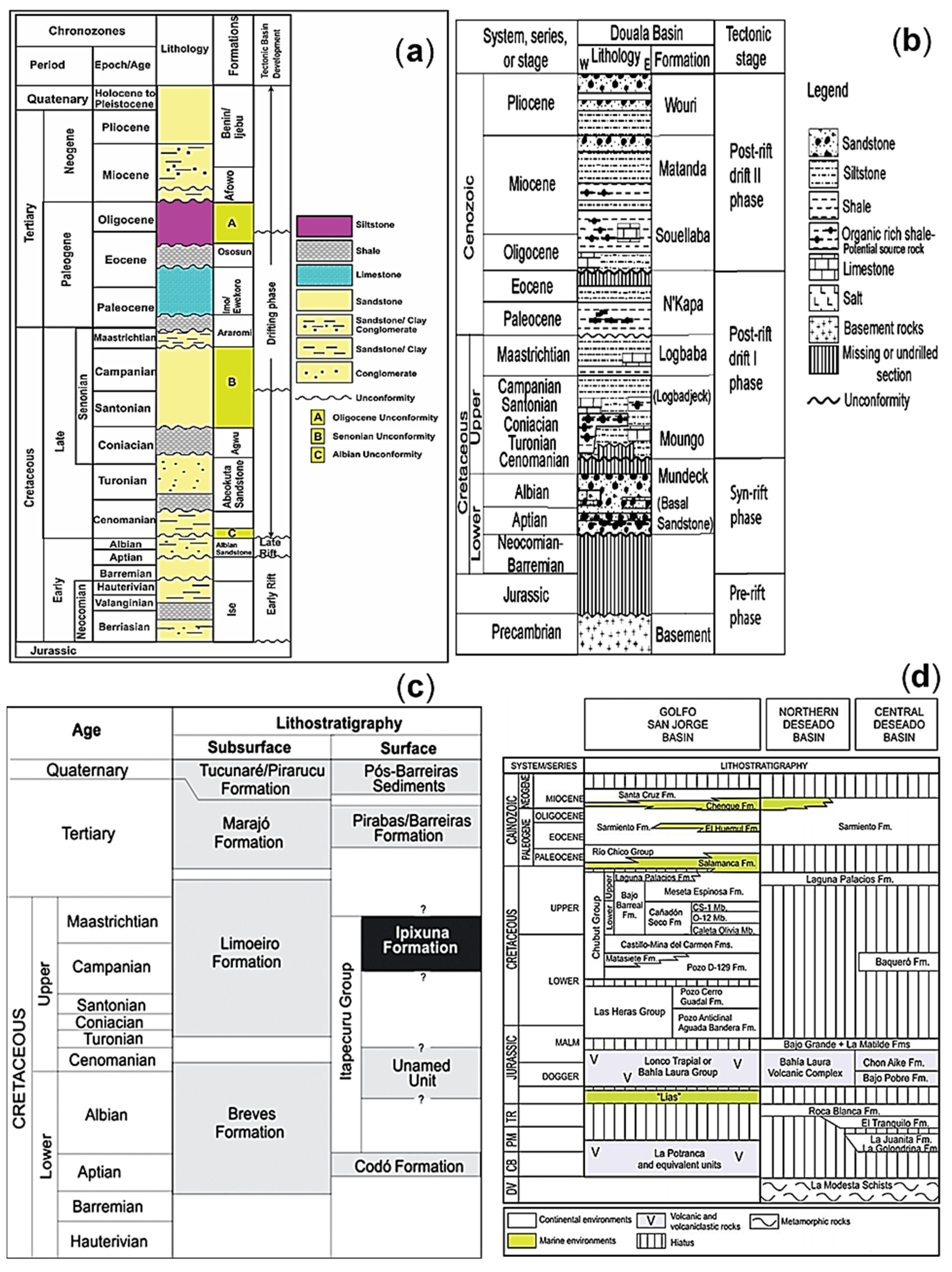

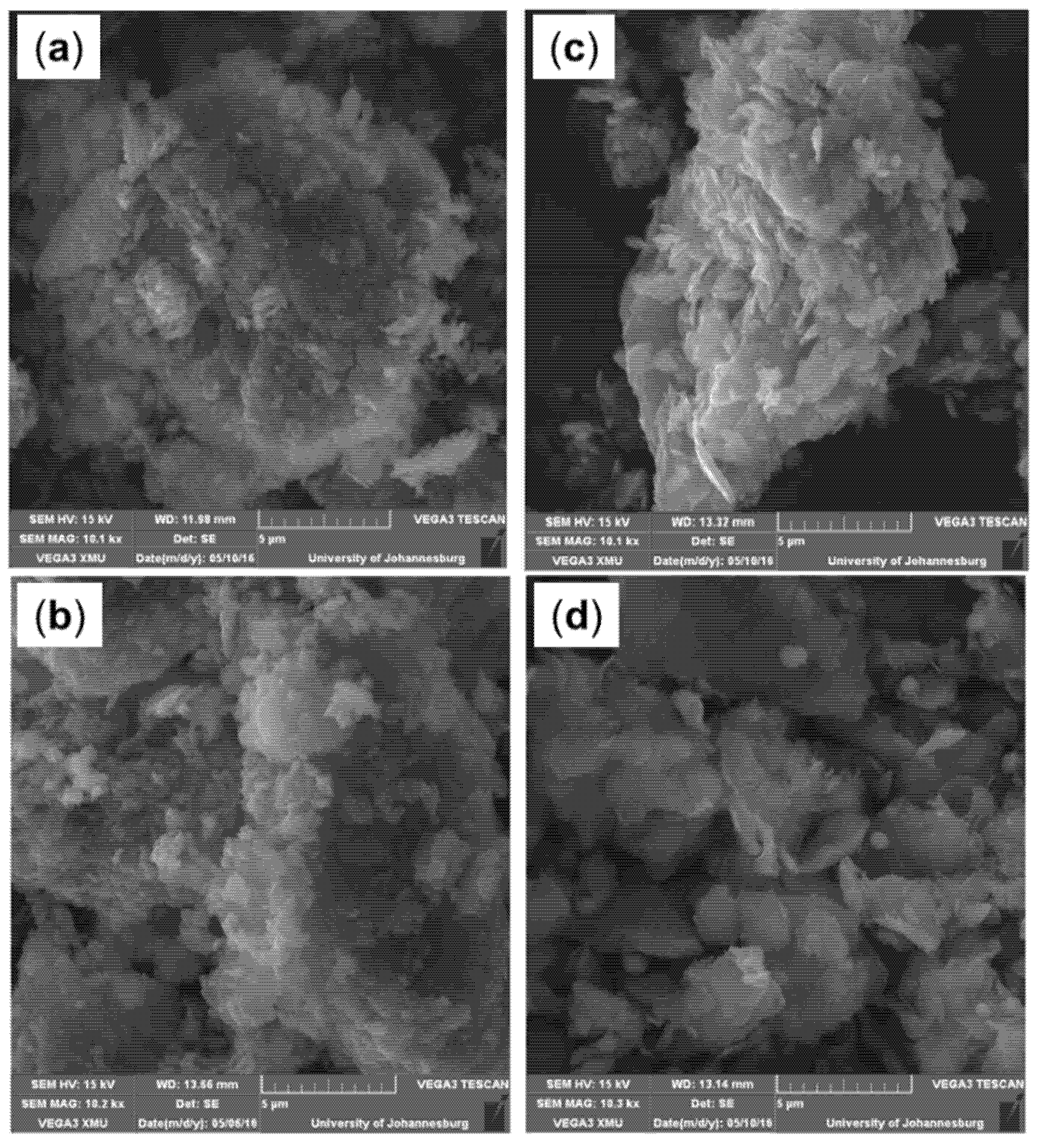
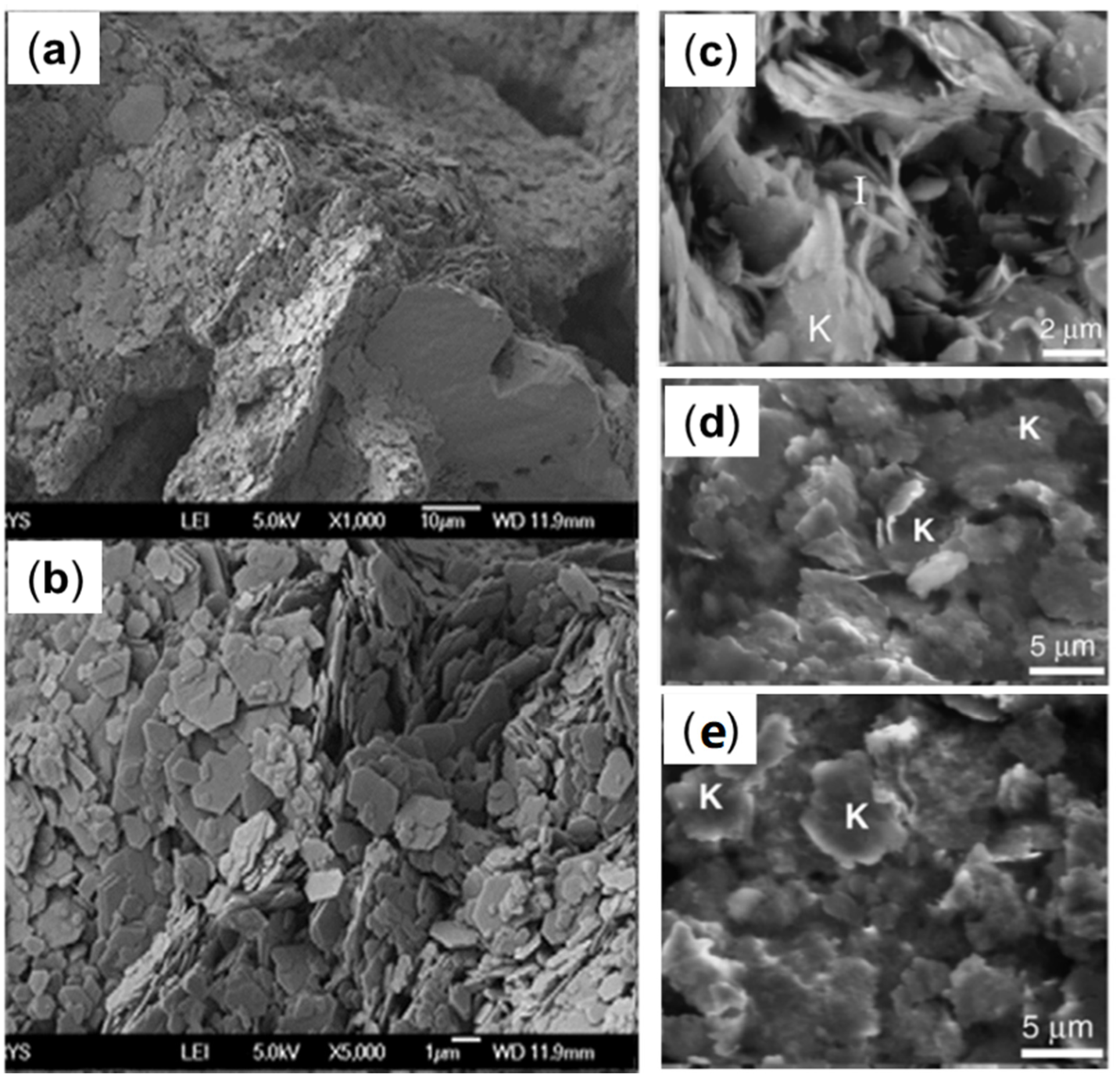
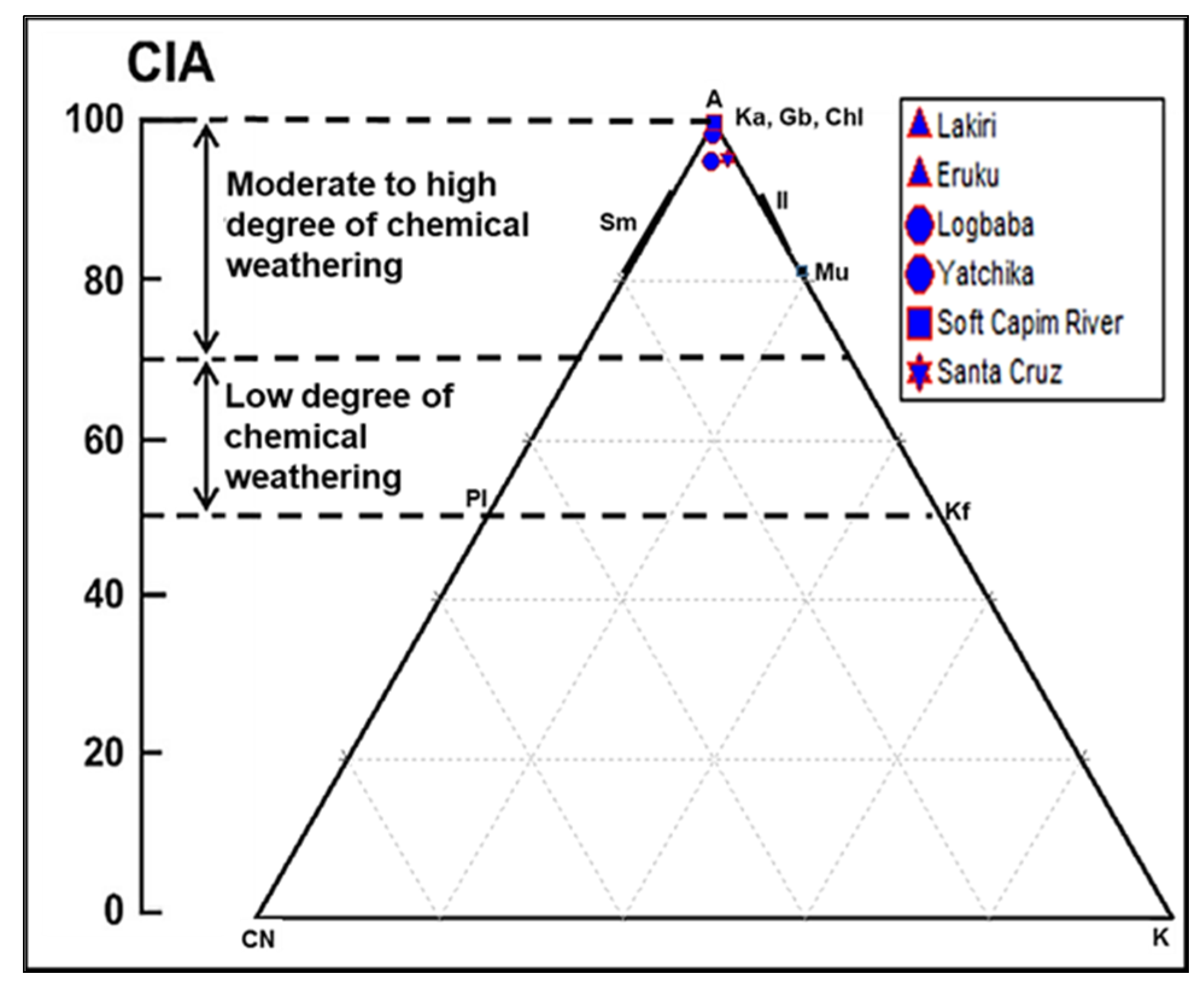
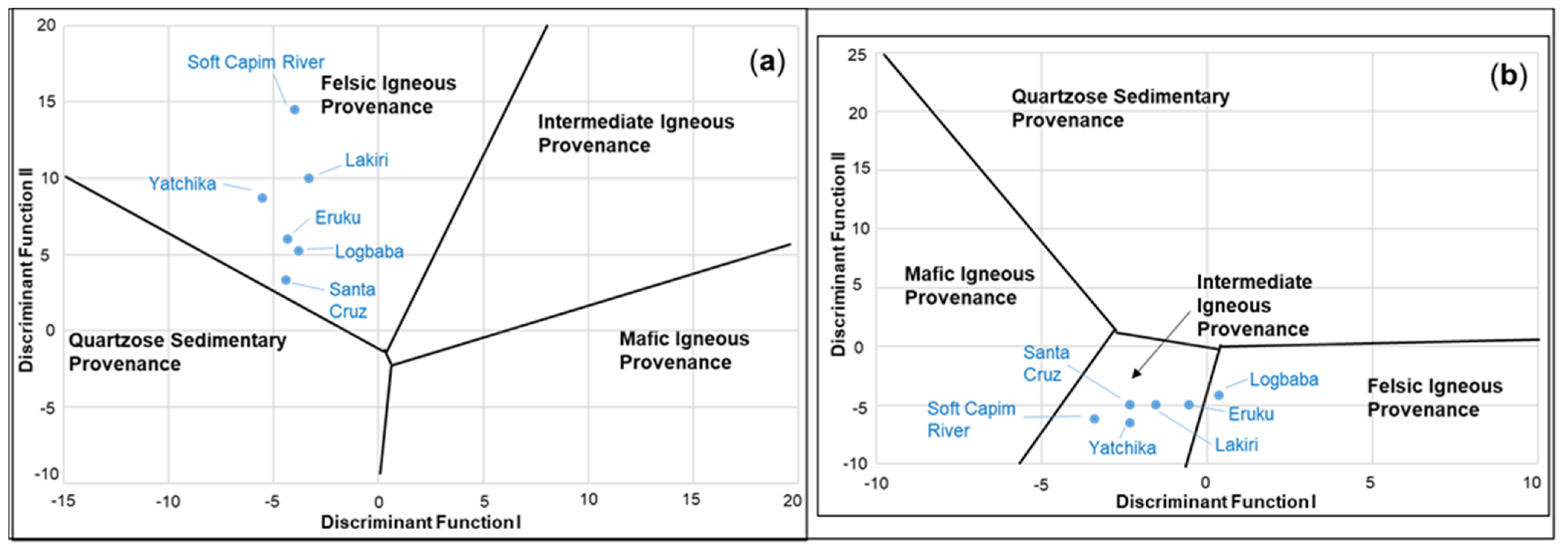
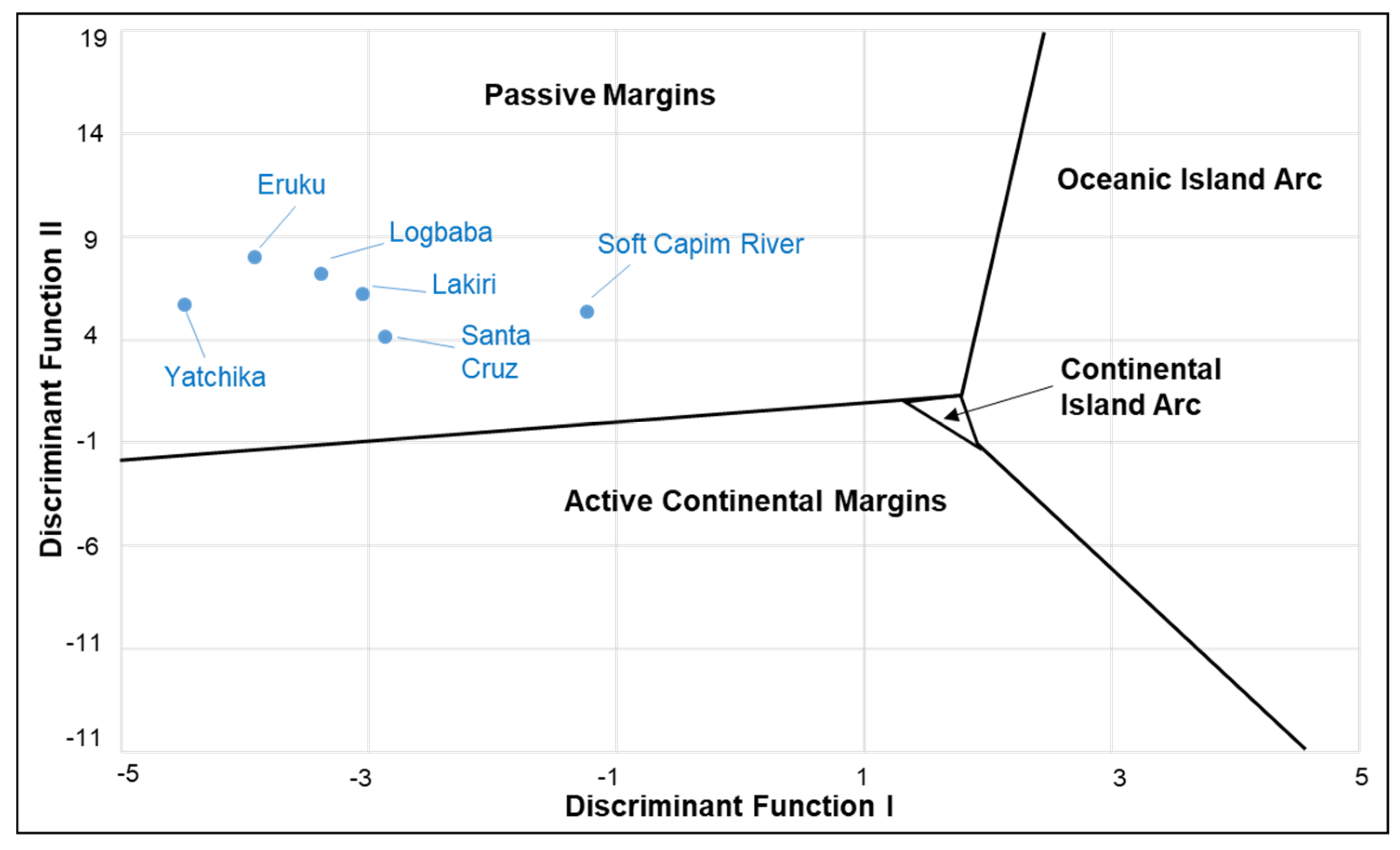
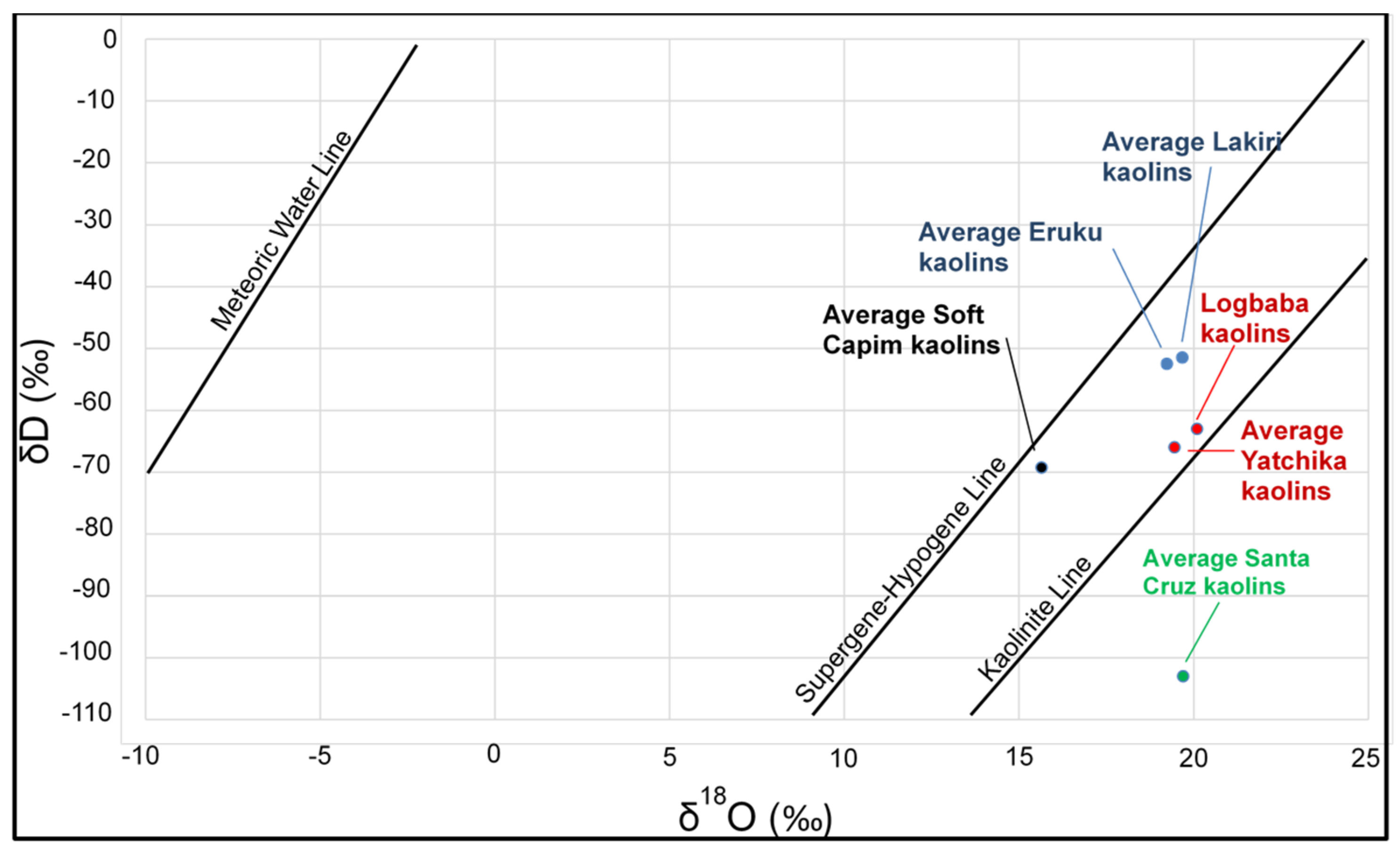
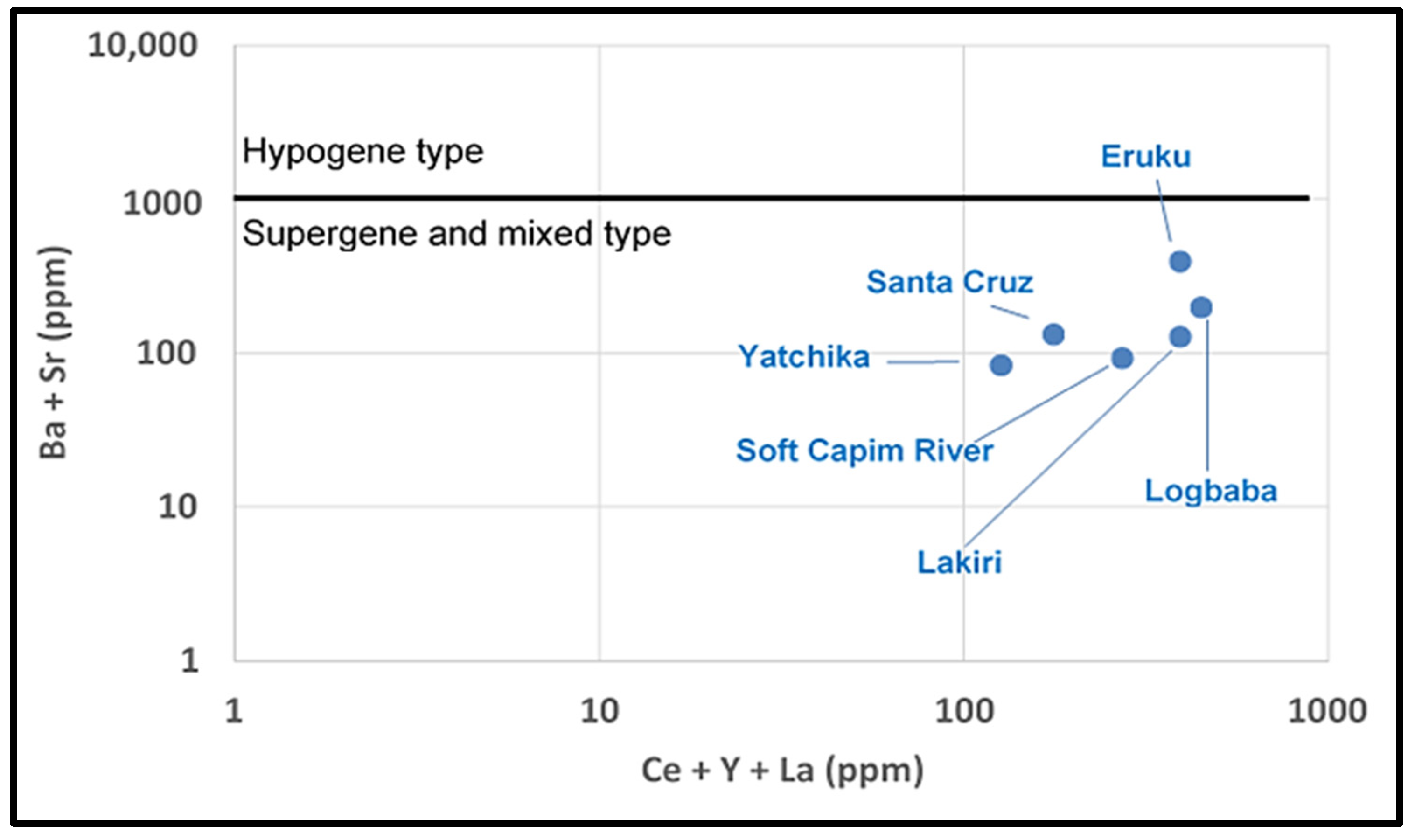
| Country | Deposits | Methods | References | ||
|---|---|---|---|---|---|
| Major/Trace Elements | Mineral Phases/Morphology | O/H Isotope | |||
| Nigeria | Lakiri Eruku | XRF 1/LAICPMS 2 | XRD 3/SEM 4 | FDXPMS 5 | [30,42,43,44] |
| Cameroon | Logbaba Yatchika | XRF 1/ICPMS 6 | XRD 3/SEM 4 | FDXPMS 5 | [45,46,47] |
| Argentina | Santa Cruz | XRF 1/INAA 7/ICPOES 8 | XRD 3/SEM 4 | SVGID 9/SS 10 | [36,37] |
| Brazil | Soft Capim River | ICPAES 11/ICPMS 7 | XRD 3/SEM 4 | FMTDMS 12/ TFTCEA 13 | [35,48,49] |
| Country | Deposit | Ka | Qz | I/S | Sm | M | Fd | Ac | HI |
|---|---|---|---|---|---|---|---|---|---|
| Nigeria | Lakiri 1 | 99 | 1 | - | - | - | - | trace | 0.99 a |
| Eruku 1 | 78 | 16 | - | - | 4 | - | 2 | 0.98 a | |
| Cameroon | Logbaba 2 | 48 | 41 | 2 | 5 | - | - | 4 | - |
| Yatchika 2 | 42 | 34 | 5 | 14 | - | - | 5 | - | |
| Argentina | Santa Cruz 3 | 50 | 35 | 6 | 4 | - | 2 | 3 | 0.40 |
| Brazil | Soft Capim River 4 | 98 | 1 | - | - | - | - | 1 | 1.11 b |
| Nigeria | Cameroon | Argentina | Brazil | |||
|---|---|---|---|---|---|---|
| Lakiri 1 | Eruku 1 | Logbaba 2 | Yatchika 2 | Santa Cruz 3 | Soft Capim River 4 | |
| SiO2 | 49.64 | 56.82 | 61.38 | 51.66 | 64.35 | 44.3 |
| TiO2 | 1.60 | 2.10 | 2.35 | 1.70 | 0.55 | 0.44 |
| Al2O3 | 35.55 | 28.25 | 29.65 | 28.21 | 22.51 | 39.35 |
| Fe2O3 | 1.09 | 2.56 | 1.04 | 7.75 | 0.99 | 0.66 |
| CaO | 0.02 | 0.02 | 0.04 | 0.03 | 0.25 | <0.02 |
| MgO | - | 0.04 | 0.08 | 0.70 | 0.24 | 0.04 |
| MnO | 0.01 | 0.01 | - | - | 0.01 | - |
| Na2O | 0.02 | 0.02 | 0.02 | 0.06 | 0.09 | <0.06 |
| K2O | 0.41 | 0.20 | 0.18 | 0.99 | 0.69 | 0.02 |
| P2O5 | 0.06 | 0.11 | 0.18 | 0.12 | 0.03 | <0.09 |
| LOI | 12.57 | 10.00 | 4.76 | 9.02 | 10.11 | 14.15 |
| CIA | 99.22 | 98.38 | 99.18 | 96.30 | 96.85 | 99.75 |
| SiO2/Al2O3 | 1.40 | 2.01 | 2.07 | 1.83 | 2.86 | 1.13 |
| K2O/Na2O | 20.50 | 10.00 | 9.00 | 16.50 | 7.67 | - |
| V/Cr | 1.04 | 0.96 | 0.90 | 1.38 | 2.97 | 1.04 |
| Ni/Co | 7.88 | 5.52 | 2.95 | 7.21 | 1.97 | 8.37 |
| Country | Deposit | δ18O | δD | Temperature |
|---|---|---|---|---|
| Nigeria | Eruku 1 | 19.2 | −53 | 31.2 |
| Lakiri 1 | 19.7 | −52 | 29.9 | |
| Cameroon | Logbaba 2 | 20.2 | −64 | 20.82 |
| Yatchika 2 | 19.4 | −66 | 22.88 | |
| Argentina | Santa Cruz 3 | 19.6 | −103 | 4.87 |
| Brazil | soft Capim River 4 | 15.7 | −69 | 38.4 |
Publisher’s Note: MDPI stays neutral with regard to jurisdictional claims in published maps and institutional affiliations. |
© 2021 by the authors. Licensee MDPI, Basel, Switzerland. This article is an open access article distributed under the terms and conditions of the Creative Commons Attribution (CC BY) license (https://creativecommons.org/licenses/by/4.0/).
Share and Cite
Oyebanjo, O.; Bukalo, N.; Ekosse, G.-I. Provenance and Paleoenvironmental Studies of Cretaceous African and South American Kaolins: Similarities and Differences. Minerals 2021, 11, 1074. https://doi.org/10.3390/min11101074
Oyebanjo O, Bukalo N, Ekosse G-I. Provenance and Paleoenvironmental Studies of Cretaceous African and South American Kaolins: Similarities and Differences. Minerals. 2021; 11(10):1074. https://doi.org/10.3390/min11101074
Chicago/Turabian StyleOyebanjo, Olaonipekun, Nenita Bukalo, and Georges-Ivo Ekosse. 2021. "Provenance and Paleoenvironmental Studies of Cretaceous African and South American Kaolins: Similarities and Differences" Minerals 11, no. 10: 1074. https://doi.org/10.3390/min11101074
APA StyleOyebanjo, O., Bukalo, N., & Ekosse, G.-I. (2021). Provenance and Paleoenvironmental Studies of Cretaceous African and South American Kaolins: Similarities and Differences. Minerals, 11(10), 1074. https://doi.org/10.3390/min11101074







